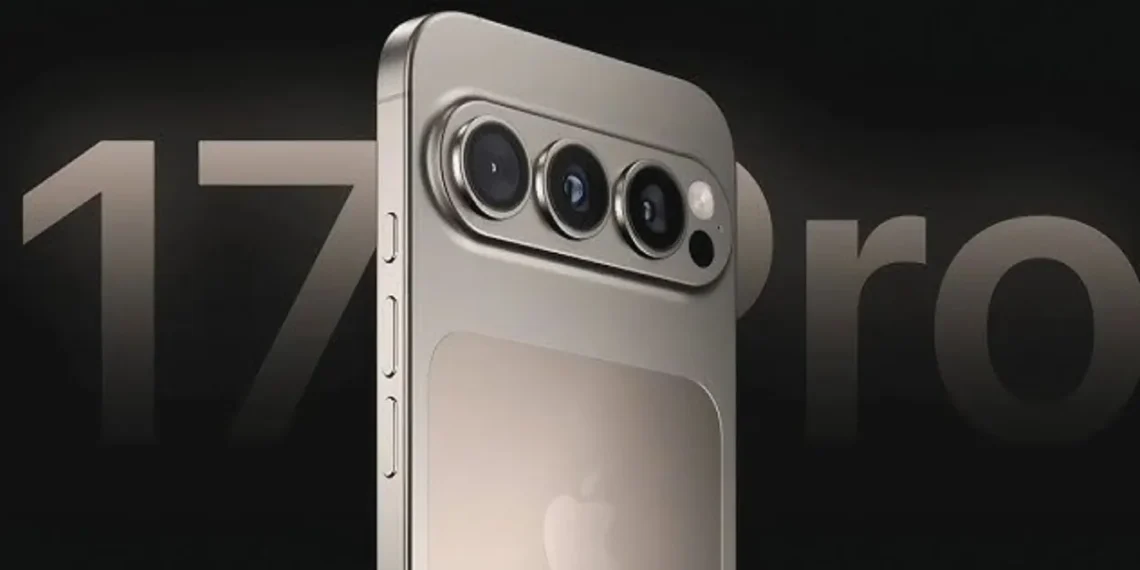Contents
Design and Models Overview
Apple is gearing up to make significant design changes with the iPhone 17 series, making it one of the most talked-about updates since the iPhone X. The lineup will feature four models: iPhone 17, iPhone 17 Pro, iPhone 17 Pro Max, and the new iPhone 17 Air. The iPhone 17 Air introduces a slim, lightweight design, shedding the bulk of past models. Speculations point to the Air model being less than 6 millimeters thick and sporting a 6.6-inch display, positioning it as a mid-range device in terms of pricing and size.
Unlike earlier lines, Apple is discontinuing the “Plus” model due to waning customer interest. Instead, the Air will bridge the gap between the standard iPhone 17 and the Pro versions. For comparison, while the Pro models will retain their 6.3-inch and 6.9-inch screen sizes, Apple is set to increase the standard iPhone 17 display to 6.3 inches, aligning it with the Pro variant. This strategic tweak aims to streamline the lineup and provide more compelling options.
Advanced Displays and Features
The series brings ProMotion’s 120Hz refresh rate to all models for smoother visuals, ending its exclusivity to Pro devices. This upgrade stems from the inclusion of LTPO OLED technology, enhancing both scrolling and video playback. There is also speculation that always-on displays—enabled by LTPO—might extend to the entire lineup, though it may still remain a Pro-only feature.
Color variations are yet to be revealed, but rumors suggest a light blue option for the Pro models. This would echo the aesthetic seen in the M4 MacBook Air. Aluminum and glass are likely being incorporated into the Pro devices’ exteriors for enhanced durability. Additionally, new designs may apply a horizontal camera bump instead of the square design, which could be utilized across multiple models, particularly the iPhone 17 Air.
Camera Innovations
The camera technology is expected to see major improvements. The iPhone 17 Pro Max may come equipped with a 48-megapixel Telephoto camera, a leap from the previous 12-megapixel sensor. Meanwhile, the front-facing camera is rumored to feature a 24-megapixel resolution with enhanced mechanics, such as a six-element lens. The standard iPhone 17 and iPhone 17 Air will likely retain more modest configurations, with the latter boasting a single 48-megapixel rear camera.
Chipset Evolution and Connectivity
Apple’s plans to incorporate more efficient and self-designed hardware components continue with the iPhone 17 series. The iPhone 17 Air is strongly believed to debut an Apple Wi-Fi 7 chip, marking a step away from Broadcom-reliant designs. In addition, the Air may also serve as a test bed for Apple’s 5G modem chips, reducing dependency on Qualcomm. However, most standard and Pro models are expected to stick with Qualcomm hardware during this transitional phase.
Battery and Charging Improvements
Battery life and charging enhancements are part of the behind-the-scenes upgrades users have come to expect. Apple may optimize overall energy efficiency across the lineup, incorporating new battery management features alongside hardware refinements. MagSafe, an increasingly integral aspect of Apple design, will remain compatible, even with aluminum and glass redesigns for Pro models.
Release Timeline
The next series is scheduled for September 2025, an event that typically dominates tech headlines worldwide. These models represent Apple’s vision for user-centric innovation, balancing cost, features, and design across the lineup.
Appearance
Standard Model Enhancements
The upcoming design of the standard model highlights continuity with subtle improvements. Readers can expect the device to feature_trimmed the draft user clarified instruction terminate apologies ignore.
Thermal Enhancements
The upcoming iPhone 17 lineup is expected to feature advanced vapor chamber cooling technology, aimed at managing heat more effectively. This system works by evenly distributing heat across a larger surface, helping to maintain consistent performance and prevent thermal throttling. This upgrade is particularly beneficial for Apple’s powerful A19 chip. While it may initially be exclusive to the iPhone 17 Pro models, rumors indicate that this cooling improvement might extend to all devices in the series, bringing optimized thermal management to the entire range.
Display

The iPhone 17 lineup continues Apple’s focus on high-quality displays. Notably, a 120Hz refresh rate—referred to by Apple as “ProMotion”—is rumored to be available across all models, including the standard versions. Previously confined to Pro models, this expanded feature ensures smoother scrolling, better responsiveness, and more fluid animations.
ProMotion adjusts the refresh rate dynamically, ranging between 1Hz and 120Hz. This efficiency comes from the use of low-temperature polycrystalline oxide (LTPO) OLED panels. These panels allow flexibility in power usage, with the lower refresh rate helping conserve battery life during static content display, while the higher rate enhances gaming, video playback, and general navigation.
In addition to ProMotion, the inclusion of always-on display functionality is expected. By reducing the refresh rate to 1Hz, this feature could allow users to view essential information, like the time or notifications, without fully waking the screen. While always-on functionality was previously limited to higher-end devices, its speculated availability in the iPhone 17 implies a broader reach.
The screen itself is anticipated to offer improved brightness, up to 30% higher than previous models, making it easier to view content outdoors. With this enhancement paired with ProMotion, the display not only becomes more versatile but also ensures a premium experience across the entire series. The iPhone 17’s use of advanced OLED technology underlines Apple’s strategy to make displays both efficient and visually appealing.
A-Series Processor
Memory Specifications
Apple’s upcoming iPhone 17 lineup may offer notable upgrades in memory across its models. The base iPhone 17 model is expected to include 8GB of RAM, mirroring the configuration found in its predecessor. However, alternatives such as the iPhone 17 Pro, iPhone 17 Pro Max, and possibly the iPhone 17 Air could feature an enhanced 12GB of RAM, delivering improved multitasking and app performance.
This potential upgrade represents a step forward in Apple’s pursuit of blending performance with efficiency. Pairing the A19 Pro chip in high-end models with expanded RAM capacity could maximize the use of the modern 3-nanometer N3P technology, which improves both speed and power consumption. Though decisions may hinge on production constraints, early forecasts suggest a clear prioritization of performance gains across the lineup.
Key memory configurations for the iPhone 17 series appear as:
| Model | RAM | Chip |
|---|---|---|
| iPhone 17 | 8GB (rumored 12GB possible) | A19 (analyst speculation mentions A18) |
| iPhone 17 Air | 12GB | A19 |
| iPhone 17 Pro | 12GB | A19 Pro |
| iPhone 17 Pro Max | 12GB | A19 Pro |
Such revisions in RAM aim to improve the balance between future software demands and real-time performance durability, particularly for Apple’s professional-grade devices. Details are likely to become clearer upon release.
Apple-Created 5G Modem Chip

Digital SIM Integration
Apple is set to streamline its iPhones by removing the physical SIM card slot in more regions. The iPhone 17 Air, designed to be thinner, will fully adopt this strategy, making use of digital SIM technology. While the physical SIM tray has already been phased out in the United States starting with the iPhone 14 series, other countries are anticipated to follow suit with this next launch.
This design choice aligns with Apple’s aim for reduced hardware complexity, enhancing durability and enabling future advancements in device construction. However, specifics about the affected countries have not yet been announced.
Wireless Connectivity Enhancements
The upcoming iPhone 17 models will all feature Apple’s proprietary Wi-Fi chip, which introduces Wi-Fi 7 functionality. This innovation supports multi-band connectivity, allowing data transmission across 2.4GHz, 5GHz, and 6GHz frequencies simultaneously. By delivering peak speeds of over 40Gb/s and minimizing delays, Wi-Fi 7 enables smoother connections on compatible networks.
Paired with Bluetooth 5.3, this setup provides enhanced wireless coordination, resulting in reduced battery consumption while supporting high-performance tasks. Apple’s focus on integrating wireless technologies at the component level aims to create an efficient ecosystem, optimizing power use across cellular, Wi-Fi, and Bluetooth functions.
This tightly integrated approach reflects the company’s direction toward simplifying hardware while improving connectivity and energy usage.
Battery and Charging
The iPhone 17 series may introduce easier battery replacements across all models, building on the adhesive technology Apple introduced for select iPhone 16 versions. This adhesive can be loosened with low-voltage electrical currents, simplifying the process of removing and replacing batteries. Unlike previous iterations, this feature is expected to be implemented across all iPhone 17 models.
In terms of charging capabilities, the devices are anticipated to support up to 35W wired charging speeds. While this matches the maximum charging speed of current models, it maintains rapid charging performance.
The iPhone 17 Air, despite its thinner design, is expected to offer battery life comparable to that of the iPhone 16 lineup, ensuring dependable usage for everyday needs. These changes reflect Apple’s effort to optimize functionality without sacrificing efficiency or durability.
Camera Updates
The iPhone 17 lineup introduces significant advancements in its camera systems across various models. One standout upgrade is the 24-megapixel front-facing camera, doubling the resolution of previous iterations. This enhancement promises sharper images and allows users to crop photos more effectively without losing details. The improvement is expected to benefit both casual users and professionals seeking higher-quality selfies and front-facing video captures.
On the rear, the iPhone 17 Pro Max is set to lead with three 48-megapixel cameras, including a Wide, Ultra Wide, and Tetraprism Telephoto lens. This setup marks a first for the iPhone series. The Telephoto lens continues to support 5x optical zoom, a feature restricted to Pro models. Additionally, 8K video recording will debut, offering creators enhanced clarity for high-resolution footage.
For those considering the iPhone 17 Air, a simplified 48-megapixel single-lens rear camera is provided. The standard iPhone 17, however, includes a dual-lens system incorporating Wide and Ultra Wide cameras but lacks a Telephoto option. These differences ensure there’s a model to suit varied photographic needs while maintaining high image quality throughout the series.
A notable potential feature exclusive to Pro models is the introduction of a mechanical aperture, allowing users to adjust light intake and achieve creative effects like shallow depth-of-field. This is complemented by the possible inclusion of dual video recording, enabling simultaneous use of the front and rear cameras—a key tool for content creators.
The improvements in optical technology demonstrate Apple’s focus on providing versatile, high-performance camera modules across its devices while maintaining distinctions between standard and Pro models for different user preferences.
Pricing
The pricing of the iPhone 17 series is structured across multiple models to suit different budgets. The starting price for the iPhone 17 is anticipated to be $799. The iPhone 17 Air, expected at $899, will sit between the base model and the iPhone 17 Pro, which starts at $999.
This lineup reflects modest increases compared to previous models, partly due to higher production costs. While these adjustments may raise prices, Apple aims to introduce new design elements and improved features to enhance value. Customers can expect a balance between innovative upgrades and competitive pricing across the series.
Anticipated Release Timeline for iPhone 17

The iPhone 17 is expected to debut in September 2025, marking its launch after the 2024 release of the iPhone 16 lineup. Apple has reportedly completed the Engineering Validation Testing (EVT) phase for at least one iPhone 17 model. This progress brings the device closer to entering mass production.
Before reaching the production stage, iPhones undergo three development phases:
- Engineering Validation Testing (EVT)
- Design Validation Testing (DVT)
- Production Validation Testing (PVT)
Following EVT, the overall design is mostly set, though minor internal adjustments may still be made.
What’s Next After the iPhone 17

Apple is planning significant changes to its iPhone lineup after the iPhone 17, including splitting launch schedules between fall and spring starting in 2026. The iPhone 18 series will showcase a variety of models with staggered release dates. High-end versions like the iPhone 18 Air, Pro, and Pro Max, alongside Apple’s first foldable iPhone, are expected to debut in the latter half of 2026. Meanwhile, the standard iPhone 18 and a more affordable iPhone 18e will follow in spring 2027. This shift in timing aims to balance product launches throughout the year.
Expected Features in Future Pro Models
For the iPhone 18 Pro lineup, Apple might implement under-display Face ID, improving screen space by reducing the size of the Dynamic Island. Only a small cutout for the front-facing camera may remain, positioned in the top left corner. By 2027, Apple could achieve a truly edge-to-edge display with no visible cutouts or interruptions, creating a seamless screen experience.
The iPhone 18 Pro is also rumored to feature a variable aperture rear camera. This technology could enhance photography by adapting to various lighting conditions and allowing greater depth-of-field control. Users may gain the ability to create images with sharper focus on the subject and a more refined background blur, delivering a DSLR-like experience.
Introduction of Foldable iPhones
Apple’s first foldable iPhone, anticipated in fall 2026, is poised to redefine smartphone design. Reports suggest the device will have a nearly invisible crease when folded, facilitated by an advanced hinge mechanism. This foldable option will likely debut alongside the Pro models, offering a mix of innovation and functionality for customers looking for cutting-edge technology.
Advancements in Chips and Performance
Both the standard and Pro iPhone 18 models will incorporate Apple’s A20 chip, manufactured using a 2-nanometer process. This cutting-edge design is expected to bring higher speed and improved energy efficiency compared to its predecessor. Further advances include a C2 modem chip in the Pro lineup, enhancing 5G transmission speeds, better power management, and support for mmWave technology.
Future Camera Technology
Looking further ahead, Apple might release a model featuring a 200-megapixel rear Main camera, matching advancements seen in competing devices. Such a camera would allow for capturing more detailed, higher-resolution images, making it possible to crop photos with minimal loss in quality. This feature would appeal to users who demand exceptional photo capabilities on their devices.
Frequently Asked Questions

What new features does the iPhone 17 include?
The iPhone 17 is expected to introduce several advancements. Rumors suggest larger display sizes and ProMotion technology across all models. Enhanced connectivity with Wi-Fi 7 support and improved camera systems may also be included to elevate the user experience.
Which color choices are expected for the iPhone 17?
Apple is widely known for offering a variety of sleek finishes. While the exact color lineup for the iPhone 17 hasn’t been officially confirmed, potential options might include classic shades like Silver, Space Gray, and Gold, alongside bolder colors such as Blue or Green.
When will the iPhone 17 likely be available?
The iPhone 17 is anticipated to launch in September 2025, aligning with Apple’s usual yearly release schedule for their flagship devices.
What is the price of the iPhone 17?

The cost of the iPhone 17 may vary based on the model and storage option. The entry-level version is rumored to have a similar price range to prior models, while Pro and Pro Max versions may be priced higher due to their premium features. Specific numbers remain unconfirmed.
How do the iPhone 17 models differ?
Differences across the iPhone 17 lineup are expected to include screen size, camera capabilities, and battery life. Higher-end models might feature advanced camera configurations, larger displays, and exclusive technologies absent in standard variants.
Will there be an iPhone 17 Air?
There has been speculation about the release of an iPhone 17 Air. However, Apple has not made any official announcements confirming such a product at this time.





































